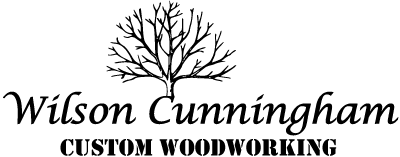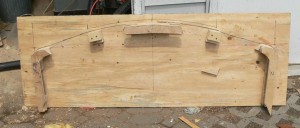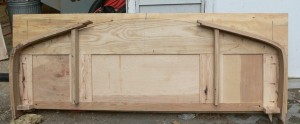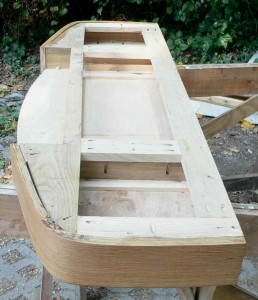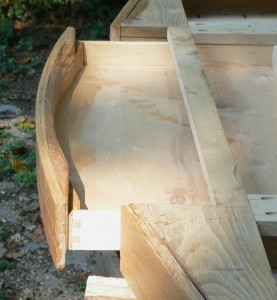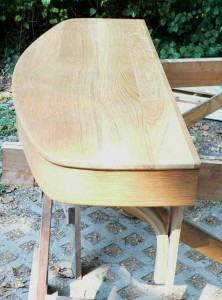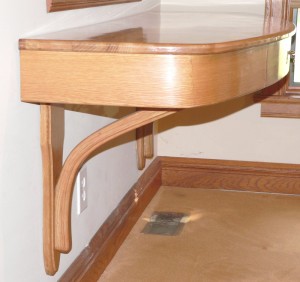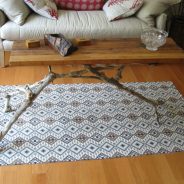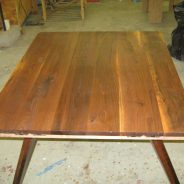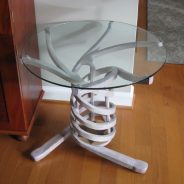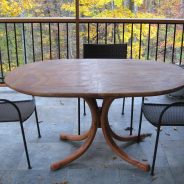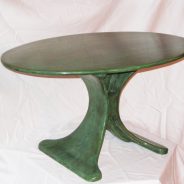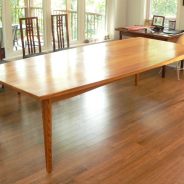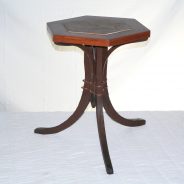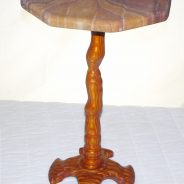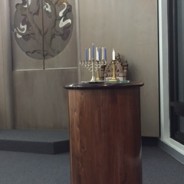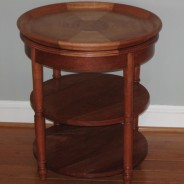Wall Hung Table
Wall Hung table
Wind Blows Table
Wind Blow Strong wind is a poorly trained arborist tree trimmer who leaves the job clean-up to you. A 2012 Deracho wind blow harvested large branches from a Sycamore tree. During clean-up operations branch intersections were directed to air drying and future ‘parts’ to make this table’s support structure. The natural bark skin provides the support structure’s final finished surface. Chestnut salvaged from roof rafters A carpenter friend in Upstate New York provided chestnut roof rafters salvaged from a old garage tear...
read moreSmall dining table
A small dining table offers an elegant option for those with limited dining area space. The 36″ x 42 ” footprint offers a tightly spaced 4 person dining table. The two-directional splayed legs create a very stable footing that maximizes legroom for this seating arrangement. Simply flip up the two (or one) 6″ x 42″ expansion leaves for a spacious 48″ x 42 ” hexagon shaped eating area (one = 42″ x 42″) with seating for 4 people. Six people can sit at this 48″ x 42″ configuration....
read moreBistro table
Bistro table features a spiral pedestal formed by three legs. Laminations of white oak create the twisted spiral leg shape. After hand-shaping the leg, a multi-layer paint topcoat imparts a translucent quality to the surface. A 30 inches diameter glass top sits 27 inches above the floor. Watch the How it was made video on YouTube.
read morePatio table with Sandstone top
Patio table with sandstone top features accommodations for six around 5 feet X 3 feet elliptical top. Four Rainbow sandstone landscape flagstone (30” X 18” – metric nominal) slabs are pattern matched to showcase a nature-painted dining surface. After cutting the elliptical pattern, the stones attach to a ¾ inch plywood substructure with fiberglass and epoxy. Edge profiling readies the top for applying a water-repellent sealer. This top perches on a steam bent white oak pedestal 30 inches above floor level. Lamination of two ¾ “thick white oak...
read moreElliptical coffee table
Elliptical shapes visually soften the hard-edge appearance of a circle. Essentially, ellipses are “rectangular” circles. An ellipse with dimensions similar to the “golden rectangle” shape has more visual appeal than a circle. This coffee table’s design uses “golden rectangle” ellipses. The elliptical top (36 inches x 24 inches) sits on a base (18 inches tall) created from intersecting ellipses. The solid Poplar construction is faux finished to a jade like appearance with multiple layers of custom-tinted varnishes. This small table’s...
read moreReclaimed pine table
Reclaimed pine from architectural salvage provides a way to use Pine harvested from established forests (harvested ca. 1900). These forests created lumber with tight grain (up to 20 growth rings per inch), reddish caramel color and a harder surface than the quick growing pine harvested currently. A reclaimed pine flooring source became available about the same time a custom wanted a lighter-colored wood dining table that had some “character” . The customer specified a 110 inches long table with arched sides – 3.5 inches drop...
read moreMultiple use side table
A side table stands about 18 to 24 inches tall. The height and usually small surface area top accommodates placement where you want an usable surface within arm’s reach when seated in an armed chair or sofa. The low stature allows usage as a bedside table or plant stand but it makes the table impractical as a comfortable table for eating or writing. Many examples of this table type are found in this portfolio. Billets split from a black walnut log form all the support structure elements of this side table. The natural live-edge formed...
read morePlywood edge furniture
Plywood’s perceived features: sheet material of standard width, length, thickest building materials available at the home center, cheaper than solid wood ($/square foot), more dimensionally stable than solid wood, thin surface veneers prone to splintering and “sand-through” during finishing, requires edge treatment to hide the ply construction, Bottom line many think plywood should be restricted to unseen surfaces ( e.g. drawer bottoms, cabinet shelves and backs) or not used at all in fine furniture. Other than...
read moreShabbath Ritual Table
I received a request from a synagogue to construct a round table that could be used to store items used during Shabbath services. The request was pretty much non-specific – round cabinet, 36 inches tall, about 24 inches in diameter with a door and drawer. No wood species was specified. I knew that I could create cylindrical objects from a multifaceted polygon to make the main body using the technique mastered for a previous project ( Rolling up a circle) (Smooth the surface to round). I had a supply of 4/4 walnut on hand so the it...
read moreRound accessory table
This simple round accessory table required the use of every major pieces of equipment in the shop. The project incorporated the diverse skills of geometric layout, steam bending, glue lamination and lathe turning. Ironically, the complex skills to make the parts ended up being screwed together – not a lot of fancy joinery required to complete the round accessory table. The round accessory table construction started with making the segmented octagonal top which is then cut into a circle and profiled on a lathe. The segments were cut...
read more